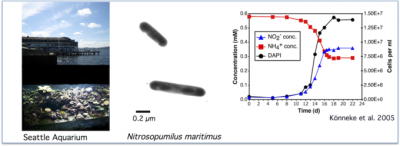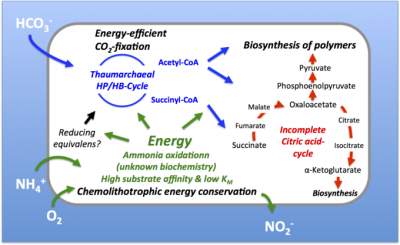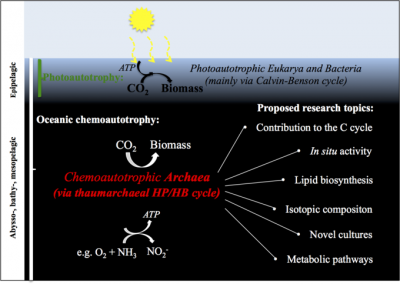- Marine Archaea
- Research
Research
DFG Heisenberg-Group: Archaeal life in the Ocean "Metabolic activity and biogeochemical relevance of marine archaea"
Guiding scientific questions of our research:
- What are the physiological capacities of marine/planktonic archaea?
- Which metabolic pathways do marine archaea use to thrive in oligotrophic ocean waters?
- How active are marine archaea in their environment?
- What are the ecological and biogeochemical roles of the abundant but yet not characterized archaea in the ocean?
Background

Fig.1: The first culture of a planktonic archaeon (Nitrosopumilus maritimus) was obtained from a fish tank of the Seattle Aquarium. By growing chemolithoautrophically with ammonia as energy- and carbon dioxide as sole carbon source, N. maritimus represents the first nitrifyer within the microbial domain Archaea. The disocovery of ammonia-oxdizing archaea in the Ocean has tremendousy changed our understanding of the marine nitrogen cycle.

Fig. 2: Central metabolism of N. maritimus. Planktonic AOA are perfectly adated to low-nutrient conditions as usually found in the open ocean. Their chemolithotrophic energy conservation pathways enable AOAs to oxidize ammonia in extremely low concentrations and to outcompete their bacterial counterparts. AOAs use an energy-efficient autotrophy pathway to compensate the permanently low supply of energy.
Research topics
- Activity of pelagic archaea and their contribution to the carbon cycle in the ocean
- Biosynthesis and function of the thaumarchaeal cytoplasmic membrane and the cell-surrounding protein layer
- Biochemical characterization of metabolic processes in ammonia-oxidizing archaea
- Cultivation and characterization of yet uncultured marine archaea
- Calibration of biogeochemical proxies and isotopic investigations on the archaeal origin of climate relevant greenhouse gases
Fig. 3: Schematic overview of my interdisciplinary approach to explore the metabolic activity of pelagic archaea based on the hypothesis that the thaumarchaeal autotrophic HP/HB cycle represents the most important carbon fixation pathway in the dark, aphotic ocean.



